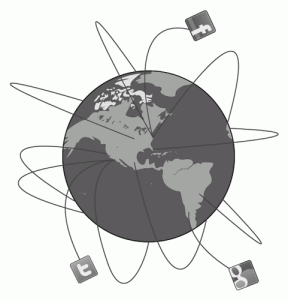The effect of social media on Occupy
The striking images of Rodney King being beaten by a group of policemen from the Los Angeles Police Department sent shockwaves through the already frustrated Los Angeles African American community. It didn’t take long for the tape to extend those shockwaves not only throughout California, but the entire nation.
The L.A. riots, which officially started on April 29, 1992, arose as a response to what a frustrated and impoverished mixed-race community felt was racial profiling and abuse by the police that had long gone unchecked, after a court acquitted all four officers under investigation of any wrongdoing. The rioting resulted in 53 people dead, and over $1 billion in damages.
With the Occupy movement catching much of the nation’s attention, a couple of questions could be asked about the powerful role the media could play in igniting similar backlash.
Will a signifying moment make the movement take the next step into action? How will our wired generation process such images today?
According to The New York Observer, the Occupy protesters have a mixed agenda in which they aim to protest against several different things, including the mortgage crisis, health care, war, and college tuition, among other issues.
The Occupy Wall Street protest began in September as a small encampment of activists with mostly inscrutable objectives that were largely ignored by the media. As time passed, it exploded into a nationwide series of demonstrations, drawing support from unions and mainstream liberal groups.
The protests then went on to earning comparisons in the media with the Tea Party movement and revolutionary pro-democracy protesters in Egypt’s Tahrir Square in Cairo.
Santa Monica College Political Science professor Steven Kurvink sees the next step depending a lot on what happens after the failed eviction of the Occupy LA encampment on Monday.
If any sort of police brutality occurs, Kurvink is certain it will be recorded and transmitted through the advanced forms of technologies that are available to a greater number of individuals than ever before.
“One thing that hasn't changed since ‘the old days’ is that protest movements still need to mobilize their base while winning over various ‘third parties’ such as public opinion, potential allies, the media and political elites,” Kurvink said. “What has changed is that today's protestors now have new and innovative ways of achieving their goals.”
According to Kurvink, our wired generation will process such an image through social media and YouTube, to facilitate the rapid dissemination of these images.
“Today, since just about everyone has a camera with them at all times, there are ample opportunities to record newsworthy events even if the news media is not present,” Kurvink said. “We saw this with the pepper spray incident at UC Davis.”
If such an image were to go viral, Rachel Wright, executive editor of non-profit news site DailySource.org, thinks it would further mobilize the wired generation and get the support of greater America.
“There have been several striking images and videos to go viral, yet they have not caused a national reaction like that of Rodney King,” Wright said. She pointed to recent incidents of pepper spray use against demonstrators, including a young woman at Occupy Portland being sprayed in the mouth as she yells, and an 84-year-old woman being helped after a pepper spraying at Occupy Seattle.
“I've heard the Occupy movement is our version of the Arab Spring,” Wright said. In early 2011, connected Middle Eastern youths were critical in uprisings by doing all they could to let the outside world know about their experiences, igniting protest and spreading across the Arab world.
Wright stated that citizen images and videos of the UC Davis incident were being compared to the iconic, historic images of Kent State, aside from the fact that the UC Davis incident did not cause the same level of violence.
“Sadly this type of violence would raise [attention of] the Occupy movement to that of Kent or the LA riots,” said Rachel Wright.
Another missing link to the Occupy movement, according to Wright, is that the Occupy movement has failed to capture the hearts of the majority of Americans.
“Perhaps because we don't have a key image or video clip,” she said. “And even though we all experienced the Great Recession and its continuing aftermath, it's not clear what end outcomes the Occupy movement is trying to obtain.”
In response to the legal actions the Occupy LA protestors are taking to protect their occupancy of the Los Angeles City Hall lawn, Kurvink said, “I think that the protestors can claim victory. Their voices are being heard. The caution [so far] exercised by the city and the police enhance the legitimacy of the movement.”
He also adds, “On the other hand if the police do react with brutality, that too will add to the legitimacy of the movement.”

